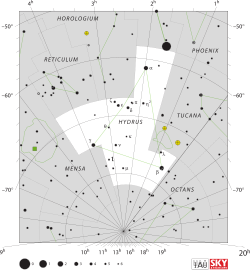みずへび座デルタ星
みずへび座δ星(みずへびざデルタせい、英語: Delta Hydri、δ Hyi)は、南天の星座であるみずへび座にある4等級の単独の恒星である[5]。
| みずへび座δ星[1] Delta Hydri | ||
|---|---|---|
| 星座 | みずへび座 | |
| 見かけの等級 (mv) | 4.09[1] | |
| 分類 | A型主系列星[1] | |
| 位置 元期:J2000.0[1] | ||
| 赤経 (RA, α) | 02h 21m 44.9406128026s[1] | |
| 赤緯 (Dec, δ) | −68° 39′ 33.889015176″[1] | |
| 赤方偏移 | 0.000020[1] | |
| 視線速度 (Rv) | 6.00 km/s[1] | |
| 固有運動 (μ) | 赤経: -49.95 ミリ秒/年[1] 赤緯: 2.48 ミリ秒/年[1] | |
| 年周視差 (π) | 23.7186 ± 0.2685ミリ秒[1] (誤差1.1%) | |
| 距離 | 138 ± 2 光年[注 1] (42.2 ± 0.5 パーセク[注 1]) | |
| 絶対等級 (MV) | 1.0[注 2] | |
δ星の位置
| ||
| 物理的性質 | ||
| 半径 | 2.29 R☉[2][注 3] | |
| 質量 | 2.25 M☉[2] | |
| 表面重力 | 3.98 ± 0.14 (log g)[3] | |
| 自転速度 | 162 km/s[3] | |
| スペクトル分類 | A2V[1] | |
| 光度 | 39.52 L☉[4] | |
| 表面温度 | 9,880 ± 360 K[3] | |
| 色指数 (B-V) | 0.034[2] | |
| 金属量[Fe/H] | 0.12[4] | |
| 年齢 | 2.09 億年[3] | |
| 他のカタログでの名称 | ||
| CPD-69 113[1] FK5 1065[1] Gaia DR2 4693818888483537664[1] GJ 9080[1] GJ 97.1[1] GSC 09144-01688[1] HD 15008[1] HIP 11001[1] SAO 248545[1] TYC 9144-1688-1[1] 2MASS J02214494-6839338[1] |
||
| ■Template (■ノート ■解説) ■Project | ||
概要
編集視等級は4.09等級で[1]、肉眼で観望するには十分に明るい恒星である。みずへび座δ星までの距離は23.71ミリ秒の年周視差に基づいており[1]、これを基に計算すると地球からは約140光年離れていることになる。また、6 km/sの視線速度で地球から遠ざかっている[1][6]。
みずへび座δ星はA2V型のスペクトル分類を持つ普遍的なA型主系列星である[1][4]。形成から2億900万年が経過しており、162 km/sという速い速度で自転していると予測とされている[3]。この高速の自転により、赤道半径が極半径よりも7%長い回転楕円体の形状になっている[7]。質量は太陽の2.25倍、半径は約2.3倍でとされる[2]。表面温度は9,880 Kと高く[3]、太陽の39.5倍も強い光度を光球から放射している[4]。みずへび座δ星の周辺で赤外超過の観測が行われているが、そのような超過は確認されていない[5]。
脚注
編集注釈
編集出典
編集- ^ a b c d e f g h i j k l m n o p q r s t u v w x y z aa “Results for del Hyi”. SIMBAD Astronomical Database. CDS. 2019年8月20日閲覧。
- ^ a b c d Allende Prieto, C.; Lambert, D. L. (1999). “Fundamental parameters of nearby stars from the comparison with evolutionary calculations: Masses, radii and effective temperatures”. Astronomy and Astrophysics 352: 555. arXiv:astro-ph/9911002. Bibcode: 1999A&A...352..555A. VizieR catalog entry
- ^ a b c d e f David, Trevor J.; Hillenbrand, Lynne A. (2015). “The Ages of Early-Type Stars: Strömgren Photometric Methods Calibrated, Validated, Tested, and Applied to Hosts and Prospective Hosts of Directly Imaged Exoplanets”. The Astrophysical Journal 804 (2): 146. arXiv:1501.03154. Bibcode: 2015ApJ...804..146D. doi:10.1088/0004-637X/804/2/146. VizierR catalog entry
- ^ a b c d Anderson, E.; Francis, Ch. (2012). “XHIP: An extended hipparcos compilation”. Astronomy Letters 38 (5): 331. arXiv:1108.4971. Bibcode: 2012AstL...38..331A. doi:10.1134/S1063773712050015. VizieR catalog entry
- ^ a b Rodriguez, David R.; Duchêne, Gaspard; Tom, Henry; Kennedy, Grant M.; Matthews, Brenda; Greaves, Jane; Butner, Harold (2015). “Stellar multiplicity and debris discs: an unbiased sample”. Monthly Notices of the Royal Astronomical Society 449 (3): 3160–3170. arXiv:1503.01320. Bibcode: 2015MNRAS.449.3160R. doi:10.1093/mnras/stv483.
- ^ Kharchenko, N. V.; Scholz, R. -D.; Piskunov, A. E.; Röser, S.; Schilbach, E. (2007). “Astrophysical supplements to the ASCC-2.5: Ia. Radial velocities of ∼55000 stars and mean radial velocities of 516 Galactic open clusters and associations”. Astronomische Nachrichten 328 (9): 889. arXiv:0705.0878. Bibcode: 2007AN....328..889K. doi:10.1002/asna.200710776.
- ^ van Belle, Gerard T. (2012). “Interferometric observations of rapidly rotating stars”. The Astronomy and Astrophysics Review 20 (1): 51. arXiv:1204.2572. Bibcode: 2012A&ARv..20...51V. doi:10.1007/s00159-012-0051-2.
